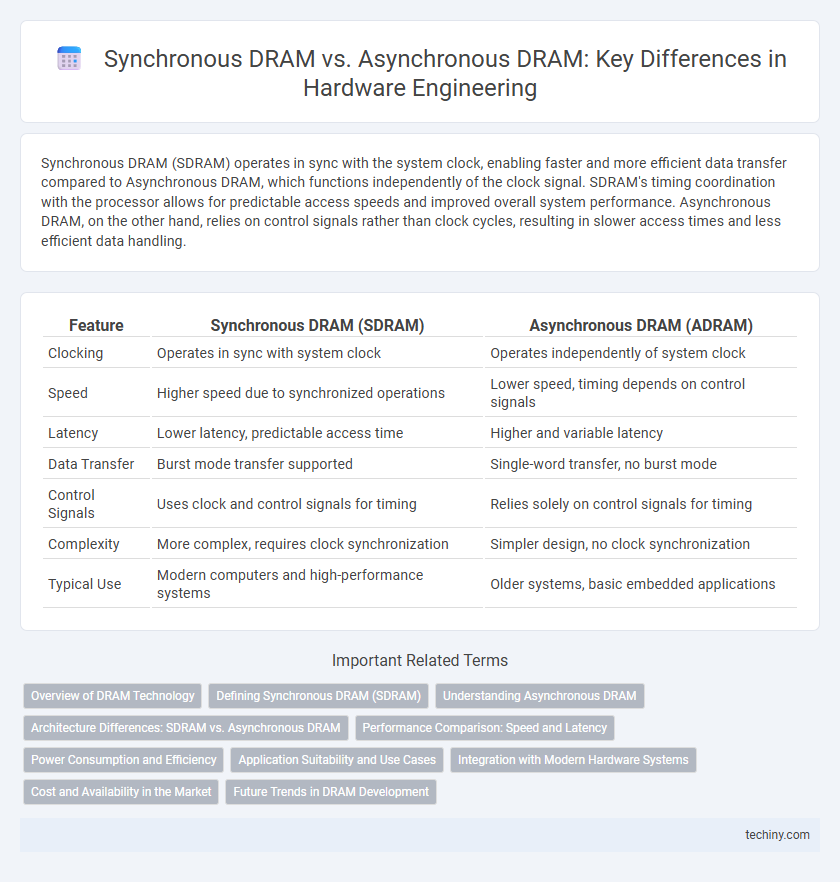Synchronous DRAM (SDRAM) operates in sync with the system clock, enabling faster and more efficient data transfer compared to Asynchronous DRAM, which functions independently of the clock signal. SDRAM's timing coordination with the processor allows for predictable access speeds and improved overall system performance. Asynchronous DRAM, on the other hand, relies on control signals rather than clock cycles, resulting in slower access times and less efficient data handling.
Table of Comparison
| Feature | Synchronous DRAM (SDRAM) | Asynchronous DRAM (ADRAM) |
|---|---|---|
| Clocking | Operates in sync with system clock | Operates independently of system clock |
| Speed | Higher speed due to synchronized operations | Lower speed, timing depends on control signals |
| Latency | Lower latency, predictable access time | Higher and variable latency |
| Data Transfer | Burst mode transfer supported | Single-word transfer, no burst mode |
| Control Signals | Uses clock and control signals for timing | Relies solely on control signals for timing |
| Complexity | More complex, requires clock synchronization | Simpler design, no clock synchronization |
| Typical Use | Modern computers and high-performance systems | Older systems, basic embedded applications |
Overview of DRAM Technology
Synchronous DRAM (SDRAM) operates in sync with the system clock, enabling faster and more efficient data access by aligning memory operations with processor timing. Asynchronous DRAM functions independently of the system clock, leading to slower data retrieval due to variable access times. The advancement from asynchronous to synchronous DRAM marked a significant improvement in memory performance, especially in latency and throughput, crucial for modern computing applications.
Defining Synchronous DRAM (SDRAM)
Synchronous Dynamic Random-Access Memory (SDRAM) operates in sync with the system clock, enabling faster data access and improved overall performance compared to Asynchronous DRAM. By synchronizing with the processor's timing, SDRAM reduces latency and increases throughput in hardware engineering applications. This timing alignment allows for predictable data retrieval, essential in modern computing systems requiring high-speed memory operations.
Understanding Asynchronous DRAM
Asynchronous DRAM operates without a synchronized clock signal, allowing data access based solely on control signals such as address and command timing. It offers flexible timing requirements but generally exhibits slower access speeds compared to synchronous DRAM, which is coordinated with the system clock. The asynchronous design is beneficial in systems where variable latency is acceptable, and tight timing synchronization is not critical.
Architecture Differences: SDRAM vs. Asynchronous DRAM
Synchronous DRAM (SDRAM) operates in sync with the system clock, enabling precise timing control and higher data transfer rates compared to Asynchronous DRAM, which lacks clock synchronization and relies on control signals for memory access. The architecture of SDRAM includes a clock input that coordinates internal operations with the CPU, minimizing latency and improving performance in high-speed computing environments. In contrast, Asynchronous DRAM's design leads to variable access times due to the absence of a centralized timing signal, making it less suitable for modern high-frequency applications.
Performance Comparison: Speed and Latency
Synchronous DRAM (SDRAM) synchronizes its operations with the system clock, resulting in faster data access speeds and lower latency compared to Asynchronous DRAM, which operates independently of the clock and suffers from increased wait times. SDRAM's ability to pipeline commands enhances throughput, making it suitable for high-performance computing tasks where timing precision is critical. In contrast, Asynchronous DRAM experiences slower response times due to its variable access cycles, limiting its effectiveness in speed-sensitive applications.
Power Consumption and Efficiency
Synchronous DRAM (SDRAM) offers higher power efficiency compared to Asynchronous DRAM by synchronizing its operations with the system clock, reducing idle power wastage during data transfers. The precise timing control in SDRAM allows for optimized power consumption profiles, especially in high-frequency applications where asynchronous DRAM's lack of synchronization leads to increased power draw and heat generation. Consequently, SDRAM is preferred in hardware designs requiring efficient power management and improved thermal performance.
Application Suitability and Use Cases
Synchronous DRAM (SDRAM) excels in high-performance computing applications such as servers, gaming consoles, and graphic workstations due to its synchronized clock operation that enables faster data access and improved system efficiency. In contrast, Asynchronous DRAM is better suited for simpler, cost-sensitive systems like embedded devices and legacy industrial equipment where timing flexibility and lower complexity are prioritized over speed. Choosing between SDRAM and asynchronous DRAM depends on system requirements for speed, latency, and design complexity in hardware engineering projects.
Integration with Modern Hardware Systems
Synchronous DRAM (SDRAM) offers superior integration with modern hardware systems due to its ability to synchronize with the system clock, enabling faster data transfer rates and improved timing accuracy. Asynchronous DRAM (ADRAM) lacks this synchronization, resulting in slower performance and limited compatibility with high-speed processors and advanced memory controllers. SDRAM's compatibility with prevalent interfaces such as DDR and DDR4 standards makes it the preferred choice for contemporary computing architectures.
Cost and Availability in the Market
Synchronous DRAM (SDRAM) generally commands a higher price due to its advanced timing control and widespread usage in modern computing systems, resulting in greater demand and availability from major suppliers. Asynchronous DRAM (ADRAM) tends to be less expensive but is less prevalent in the current market, primarily found in legacy or specialized hardware applications, limiting its availability. The cost-effectiveness of SDRAM is balanced by robust supply chains, whereas ADRAM's niche status leads to reduced production volumes and higher procurement difficulty.
Future Trends in DRAM Development
Synchronous DRAM (SDRAM) continues to dominate future trends in DRAM development due to its ability to synchronize with the system clock, resulting in higher data transfer rates and improved overall performance compared to Asynchronous DRAM (ADRAM). Emerging technologies like DDR5 and LPDDR5 are pushing the limits of SDRAM speed, bandwidth, and power efficiency to meet the demands of AI, 5G, and high-performance computing applications. Research into novel memory architectures and integration methods aims to further enhance SDRAM scalability, latency reduction, and energy efficiency, ensuring its relevance in next-generation hardware engineering.
Synchronous DRAM vs Asynchronous DRAM Infographic

 techiny.com
techiny.com